 R3 Vascular has reported the successful initiation of its first-in-human clinical study evaluating the technical and clinical performance of the R3 Vascular Magnitude bioresorbable sirolimus-eluting scaffold (BRS) in patients suffering of chronic limb-threatening ischaemia (CLTI) due to occlusive below-the-knee (BTK) arterial disease.
R3 Vascular has reported the successful initiation of its first-in-human clinical study evaluating the technical and clinical performance of the R3 Vascular Magnitude bioresorbable sirolimus-eluting scaffold (BRS) in patients suffering of chronic limb-threatening ischaemia (CLTI) due to occlusive below-the-knee (BTK) arterial disease.
A press release details that the R3 Vascular platform incorporates an innovative scaffold design and bioresorbable polymer technology resulting in biomechanical performance comparable to metallic stents. At a 98-micron strut thickness across all its usable range of diameters, the Magnitude BRS device is the thinnest BRS ever tested in this clinical setting, the release adds.
“Given the dire and unmet clinical need of patients presenting with CLTI undergoing BTK revascularisation, we are extremely pleased by the rapid progression of our programme,” said R3 Vascular CEO Kamal Ramzipoor. “Our Magnitude BRS is well-positioned to improve the clinical outcomes of these patients by providing temporary mechanical support and sustained drug delivery while reducing the well-established complications associated with permanent implants.”
“In this early clinical experience, we successfully tested the deliverability and mechanical performance of the Magnitude BRS. Post-procedural angiographic and duplex ultrasound data confirm the mechanical properties and ‘stent-like’ results of the Magnitude BRS device in presence of a high-disease burden. We are looking forward to expanding the patient population cohort and following the clinical results over time,” said Marianne Brodman (Medical University of Graz, Graz, Austria).
Juan F Granada, a strategic advisor to R3 Vascular, added: “In BTK intervention, the prevention of vessel recoil following balloon dilatation is key to prevent negative remodelling and maintain vessel patency over time. BRS offer the best of both worlds by providing vessel support while it is needed and allowing the opportunity for future reinterventions, which is important in this type of patient. The successful validation of this technology may finally offer an effective and durable way to treat patients with this complex medical condition.”













